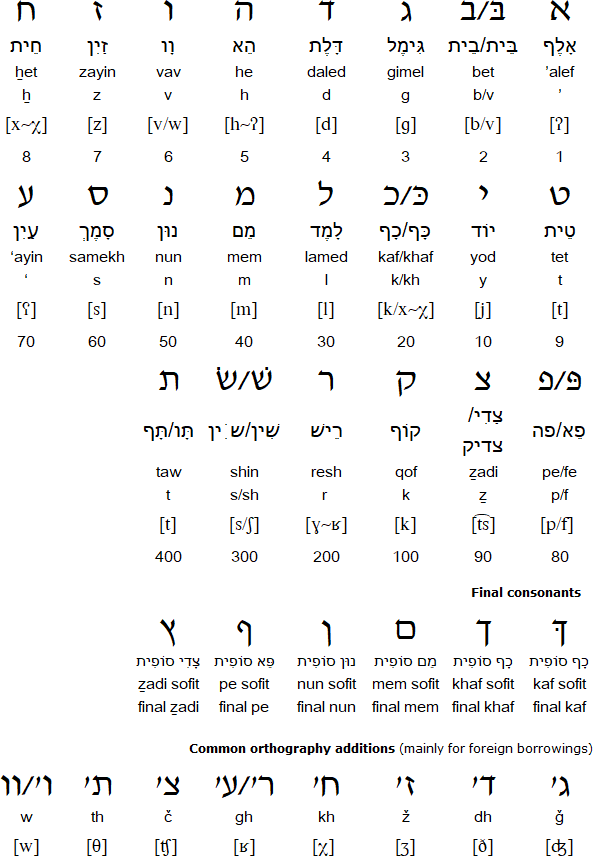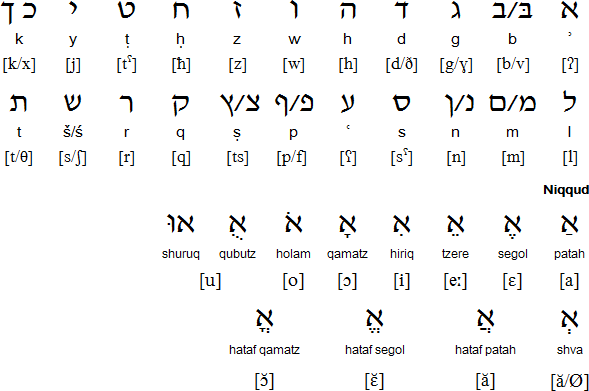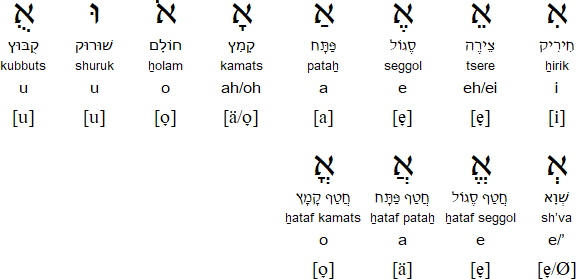During the mid-19th century the first efforts were made to revive Hebrew as a everyday language. One man who played a major role in these efforts was Eliezer Ben Yehuda (1858-1922), who was the first to make exclusive use of Hebrew in his home, and encouraged the use of Hebrew among others, as well as its use in schools.
Today Hebrew is spoken by some 5 million people in Israel, where it is an official language along with Arabic. and a further 2 to 3 million people speak the language in Argentina, Australia, Brazil, Canada, France, Germany, Palestinian West Bank and Gaza, Panama, the UK and USA.
Hebrew alphabet
The first alphabet used to write Hebrew emerged during the late second and first millennia BC. It is closely related to the Phoenician alphabet. The modern Hebrew alphabet was developed from an alphabet known as Proto-Hebrew/Early Aramaic.Notable features
- Type of writing system: abjad
- Direction of writing: right to left in horizontal lines.
- Number of letters: 22 consonants, plus final letters and diacritics
- Used to write: Hebrew, Judeo-Arabic, Ladino, Yiddish and many other Jewish languages.
- Some letters (kaf, mem, nun, fe and tzadi) have a final form (sofit), which is used when they appear at the end of a word.
- There are no separate numerals in Hebrew, instead standard western numerals (1, 2, 3, etc) are used.
- Long vowels can be indicated by the letters alef, vav, and yod. Short vowels are not usually marked, except in the Bible, poetry and books for children and foreign learners.
The Hebrew script
Modern Israeli pronunciation

Notes
- het is officially pronounced [ħ], but many people pronounce it [x]
- ʻayin is officially pronounced [ʕ], but many people pronounce it [ʔ]
Download
Download a Hebrew alphabet chart in Word or PDF format
Hebrew vowel points / Nikkud (נִקּוּד טְבֶרְיָנִי)

The first row of IPA transcriptions is the Modern Israeli Hebrew pronunciation,
the second row is the Medieval/Tiberian pronunciation.
the second row is the Medieval/Tiberian pronunciation.
Modern Cursive Hebrew script

Rashi
The Rashi style is used mainly to write commentaries on texts. It is named after Rabbi Shlomo Yitzchaki (1040-1105 AD) a.k.a. Rashi, one of the greatest medieval Jewish scholars and bible commentators. Rashi did not use the Rashi sytle to write his commentaries but it is named in honour of him.
Sample texts in Hebrew
Without vowels

With vowels

Cursive script

Transliteration
Kol benei ha'adam noldu benei xorin veshavim be'erkam uvizxuyoteihem. Kulam xonenu batevuna uvematspun, lefixax xova 'aleihem linhog ish bere'ehu beruax shel axava.A recording of this text by גל ויסברג (Gal Weisberg)
Translation
All human beings are born free and equal in dignity and rights. They are endowed with reason and conscience and should act towards one another in a spirit of brotherhood.(Article 1 of the Universal Declaration of Human Rights)
Links
Information about the Hebrew language and alphabethttp://en.wikipedia.org/wiki/Hebrew_language
http://judaism.about.com/od/hebre1/Hebrew.htm
http://www.jewishvirtuallibrary.org/jsource/judaica/ejud_0002_0008_0_08629.html









.jpg)
.jpg)

.jpg)





0 comments:
Post a Comment
Note: Only a member of this blog may post a comment.